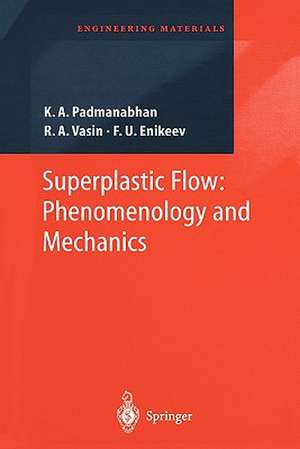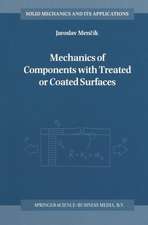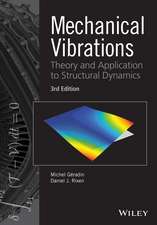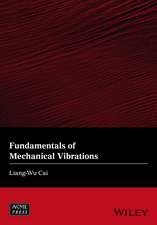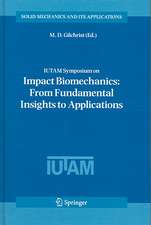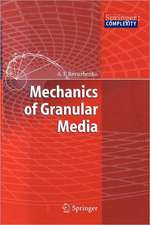Superplastic Flow: Phenomenology and Mechanics: Engineering Materials
Autor K.A. Padmanabhan, R.A. Vasin, F.U. Enikeeven Limba Engleză Paperback – 21 oct 2010
| Toate formatele și edițiile | Preț | Express |
|---|---|---|
| Paperback (1) | 948.61 lei 6-8 săpt. | |
| Springer Berlin, Heidelberg – 21 oct 2010 | 948.61 lei 6-8 săpt. | |
| Hardback (1) | 954.93 lei 6-8 săpt. | |
| Springer Berlin, Heidelberg – 26 feb 2001 | 954.93 lei 6-8 săpt. |
Din seria Engineering Materials
- 18%
 Preț: 1390.89 lei
Preț: 1390.89 lei - 18%
 Preț: 1236.99 lei
Preț: 1236.99 lei - 24%
 Preț: 829.35 lei
Preț: 829.35 lei - 18%
 Preț: 1001.02 lei
Preț: 1001.02 lei - 20%
 Preț: 573.70 lei
Preț: 573.70 lei - 17%
 Preț: 490.23 lei
Preț: 490.23 lei - 18%
 Preț: 891.33 lei
Preț: 891.33 lei - 15%
 Preț: 644.95 lei
Preț: 644.95 lei - 18%
 Preț: 892.90 lei
Preț: 892.90 lei - 18%
 Preț: 1384.75 lei
Preț: 1384.75 lei - 18%
 Preț: 1002.61 lei
Preț: 1002.61 lei -
 Preț: 343.98 lei
Preț: 343.98 lei - 18%
 Preț: 997.09 lei
Preț: 997.09 lei - 18%
 Preț: 1106.00 lei
Preț: 1106.00 lei - 18%
 Preț: 1120.99 lei
Preț: 1120.99 lei - 15%
 Preț: 703.85 lei
Preț: 703.85 lei - 15%
 Preț: 658.05 lei
Preț: 658.05 lei - 18%
 Preț: 889.75 lei
Preț: 889.75 lei - 18%
 Preț: 946.55 lei
Preț: 946.55 lei - 18%
 Preț: 1396.43 lei
Preț: 1396.43 lei - 18%
 Preț: 1101.26 lei
Preț: 1101.26 lei - 17%
 Preț: 428.09 lei
Preț: 428.09 lei - 18%
 Preț: 1111.85 lei
Preț: 1111.85 lei - 18%
 Preț: 1588.67 lei
Preț: 1588.67 lei -
 Preț: 388.45 lei
Preț: 388.45 lei - 20%
 Preț: 566.87 lei
Preț: 566.87 lei - 18%
 Preț: 949.42 lei
Preț: 949.42 lei - 15%
 Preț: 631.72 lei
Preț: 631.72 lei - 15%
 Preț: 640.88 lei
Preț: 640.88 lei - 15%
 Preț: 635.47 lei
Preț: 635.47 lei - 18%
 Preț: 1233.20 lei
Preț: 1233.20 lei - 18%
 Preț: 1548.11 lei
Preț: 1548.11 lei - 18%
 Preț: 1126.03 lei
Preț: 1126.03 lei - 15%
 Preț: 638.11 lei
Preț: 638.11 lei - 15%
 Preț: 637.46 lei
Preț: 637.46 lei - 18%
 Preț: 1217.10 lei
Preț: 1217.10 lei - 18%
 Preț: 945.62 lei
Preț: 945.62 lei - 18%
 Preț: 1224.54 lei
Preț: 1224.54 lei -
 Preț: 367.93 lei
Preț: 367.93 lei - 15%
 Preț: 639.25 lei
Preț: 639.25 lei - 15%
 Preț: 643.34 lei
Preț: 643.34 lei - 18%
 Preț: 955.08 lei
Preț: 955.08 lei - 15%
 Preț: 645.79 lei
Preț: 645.79 lei - 18%
 Preț: 1237.30 lei
Preț: 1237.30 lei - 18%
 Preț: 1114.34 lei
Preț: 1114.34 lei - 18%
 Preț: 1217.10 lei
Preț: 1217.10 lei
Preț: 948.61 lei
Preț vechi: 1156.84 lei
-18% Nou
Puncte Express: 1423
Preț estimativ în valută:
181.51€ • 190.20$ • 150.06£
181.51€ • 190.20$ • 150.06£
Carte tipărită la comandă
Livrare economică 12-26 aprilie
Preluare comenzi: 021 569.72.76
Specificații
ISBN-13: 9783642087400
ISBN-10: 364208740X
Pagini: 384
Ilustrații: XIX, 363 p. 17 illus.
Dimensiuni: 155 x 235 x 20 mm
Greutate: 0.54 kg
Ediția:Softcover reprint of hardcover 1st ed. 2001
Editura: Springer Berlin, Heidelberg
Colecția Springer
Seria Engineering Materials
Locul publicării:Berlin, Heidelberg, Germany
ISBN-10: 364208740X
Pagini: 384
Ilustrații: XIX, 363 p. 17 illus.
Dimensiuni: 155 x 235 x 20 mm
Greutate: 0.54 kg
Ediția:Softcover reprint of hardcover 1st ed. 2001
Editura: Springer Berlin, Heidelberg
Colecția Springer
Seria Engineering Materials
Locul publicării:Berlin, Heidelberg, Germany
Public țintă
ResearchCuprins
1 Phenomenology of Superplastic Flow.- 1.1 Historical.- 1.2 Mechanical Behaviour of Superplastics.- 1.3 Strain Rate Sensitivity of Superplastic Flow.- 1.4 Superplasticity from the Point of View of Mechanics.- 2 Mechanics of Solids.- 2.1 The Subject.- 2.2. Basic Concepts.- 2.3 General Laws and Boundary Value Problems.- 2.4 Mathematical Models of Materials.- 2.5 Experiments in Mechanics.- 3 Constitutive Equations for Superplastics.- 3.1 Basic Requirements of Constitutive Equations.- 3.2 Phenomenological Constitutive Equations.- 3.3 Physical Constitutive Equations.- 3.4 Construction of Constitutive Equations.- 3.5. Constitutive Equations in Tensor Form.- 3.6 Material Constants from Technological Tests.- 4 Boundary Value Problems in Theory of Superplastic Metalworking.- 4.1 General Formulation of the Boundary Value Problem for Metalworking Processes.- 4.2 Model Boundary Value Problems in Mechanics of Superplasticity.- 4.3 Numerical Solving of Boundary Value Problems in Superplasticity.- 5 Mathematical Modelling of Superplastic Metalworking Processes.- 5.1 Modelling of Superplastic Bulk Forming Processes.- 5.2 Modelling of Sheet Metal Processes.- 5.3 Deformation Processing of Materials.- 6 Problems and Perspectives.- 6.1. Influence of Strain History on Evolution of Structure.- 6.2. Constitutive Equations Including Structural Parameters.- 6.3. The Concept of Database ‘TMT—Structure—Properties’.- 6.4. Challenges in Mechanics of Superplasticity.- Appendix A: Finite Strain Kinematics of Solids.- A.1 Basic Concepts.- A.2 Theory of Deformations.- A.2.1 Strain Tensors.- A.2.2 Geometrical Sense of Strain Tensor Components.- A.2.3 Method of Determining the Principal Components of a Strain Tensor.- A.2.4 Volumetric and Deviatoric Parts of Strain Tensors.- A.3 Strain RateTensor.- A.3.1 Covariant Components of Strain Tensor.- A.3.2 Distortion and Spin Tensors.- A.3.3 Strain Rate Tensor Invariants.- A.3.4 Volumetric and Deviatoric Parts of the Strain Rate Tensor.- A.3.5 On Some Scalar Characteristics of a Deformed State.- Appendix B: Kinematics of Some Simple Deformation Modes.- B.1 Tension/Compression of a Cylindrical Rod.- B.2 Simple Shear.- B.3 Pure Shear.- B.4 Bulging of a Sphere.- B.5 Finite Strain Kinematics under Combined Loading of a Cylindrical Rod by Axial Force and Torque.- Appendix C: On Dimensional Analysis.- C.1 Basic Concepts.- C.2 Viscous Flow.- C.3 Non-Newtonian Flow.- C.4 Superplastic Flow.- C.5 Dimensionless Parameters for the Boundary Value Problem of Superplasticity.- C.6 Physical Modelling of Superplastics.- Appendix D: Group Properties of Thermoviscoplasticity.- D.1 About Single-Parameter Groups of Transforms.- D.2 Applications of Group Methods in Superplasticity.- References.
Recenzii
From the reviews:
"The book under review … is another book in the same direction to unify the two approaches to studying mechanical behaviour of materials but with a focus on the specific area of superplastic flow and forming. … There are four Appendices totaling to 60 pages … . These … greatly enhance the usefulness of the book. The book is a welcome addition to the literature on superplasticity and is a must-read to all those who want to study, understand, research and engineer superplastic flow." (Placid Rodriguez, Transactions of the Indian Institute of Metals, April, 2003)
"The book under review develops in a systematic manner, the linkages between phenomenology and mechanics. … the authors discuss the various constitutive equations available for superplastic flow and boundary-value problems with superplastic forming. … the book contains four appendices that provide useful background information … . In summary, the book is well produced, with good quality figures and equations, and it is likely to be useful for practising technologists and also at a post-graduate level in teaching/research programmes … ." (Atul H. Chokshi, Current Science, Vol. 84 (4), 2003)
"The aim of this monograph is … establishing the mechanics of superplasticity as a discipline in its own right. … a rather comprehensive overview is given on the multitude of superplastics material models available, particularly focusing on technological applications, which clearly certifies the authors’ competence in the field. The strength of the book is the compilation of numerous important references (621 explicitly cited) … . There is a lot to learn from this book." (Dr. Eva Gregorová, Materials World, Vol. 10 (4), 2002)
"The book under review … is another book in the same direction to unify the two approaches to studying mechanical behaviour of materials but with a focus on the specific area of superplastic flow and forming. … There are four Appendices totaling to 60 pages … . These … greatly enhance the usefulness of the book. The book is a welcome addition to the literature on superplasticity and is a must-read to all those who want to study, understand, research and engineer superplastic flow." (Placid Rodriguez, Transactions of the Indian Institute of Metals, April, 2003)
"The book under review develops in a systematic manner, the linkages between phenomenology and mechanics. … the authors discuss the various constitutive equations available for superplastic flow and boundary-value problems with superplastic forming. … the book contains four appendices that provide useful background information … . In summary, the book is well produced, with good quality figures and equations, and it is likely to be useful for practising technologists and also at a post-graduate level in teaching/research programmes … ." (Atul H. Chokshi, Current Science, Vol. 84 (4), 2003)
"The aim of this monograph is … establishing the mechanics of superplasticity as a discipline in its own right. … a rather comprehensive overview is given on the multitude of superplastics material models available, particularly focusing on technological applications, which clearly certifies the authors’ competence in the field. The strength of the book is the compilation of numerous important references (621 explicitly cited) … . There is a lot to learn from this book." (Dr. Eva Gregorová, Materials World, Vol. 10 (4), 2002)
Textul de pe ultima copertă
The present book aims at the following: - To outline briefly the techniques of mechanics of solids, particularly as it applies to strain rate sensitive materials, - to assess the present level of investigations on the mechanical behaviour of superplastics, - to formulate the main issues and challenges in mechanics of superplasticity, - to analyse the mathematical models/constitutive equations for superplastic flow from the viewpoint of mechanics, - to review the models of superplastic metal working processes, - to indicate with examples possible new results that can be obtained using the methods of mechanics of solids. It is intended for a variety of readers who may be interested in the phenomenon of superplasticity for different reasons: materials scientists and physicists working in educational institutions and R&D units, those who wish to work on the applications of superplasticity, engineers in industry, students at senior undergraduate and postgraduate levels and those who wish to understand the phenomenology and mechanics of superplasticity without involvement in actual research. A reader who has exposure to standard differential and integral calculus and elementary tensor calculus at a level taught to senior undergraduate students at a technical university should have no difficulty in following the treatments. The analytical procedures are explained in an Appendix with simple examples.
Caracteristici
Outlines briefly the techniques of mechanics of solids Assesses the present level of investigations on the mechani- cal behaviour of superplastics Formulates the main issues and challenges in the mechanics of superplasticity Analyses the constitutive equations for superplastic flow Reviews the models of superplastic metal working processes Dndicates with examples possible new results Includes supplementary material: sn.pub/extras
